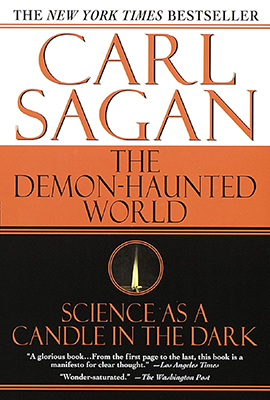The Demon-Haunted World
“The Demon-Haunted World: Science as a Candle in the Dark” is a seminal work by Carl Sagan, published in 1995. It’s a passionate defense of science and critical thinking against the encroachment of pseudoscience, superstition, and irrational beliefs. Here’s a summary:
Main Thesis:
Sagan argues that in an age of increasing scientific and technological advancement, society must embrace skepticism, reason, and evidence-based thinking to navigate the complexities of the modern world. He warns against the dangers of ignorance, credulity, and the erosion of scientific literacy.
Key Concepts:
Baloney Detection Kit: Sagan presents a toolkit for identifying and debunking flawed arguments, logical fallacies, and deceptive practices commonly used to promote pseudoscience and superstition. This includes strategies such as demanding evidence, scrutinizing sources, and applying Occam’s Razor.
The Power of Skepticism: Sagan stresses the importance of skepticism as a safeguard against deception and self-delusion. He encourages readers to question authority, challenge assumptions, and cultivate a healthy skepticism toward extraordinary claims.
The Scientific Method: Sagan explains the principles of the scientific method and its role in advancing knowledge and understanding. He emphasizes the value of empirical evidence, peer review, and open-minded inquiry in distinguishing between fact and fiction.
The Demarcation Problem: Sagan explores the challenge of demarcating science from pseudoscience and distinguishing between legitimate scientific inquiry and unfounded beliefs. He advocates for a nuanced approach that considers evidence, testability, and falsifiability.
Examples and Anecdotes:
– UFOs and Alien Abductions: Sagan examines the phenomenon of UFO sightings and alien abductions, offering rational explanations grounded in psychology, perception, and the limitations of human observation.
– Creationism vs. Evolution: Sagan critiques the arguments of creationists and advocates for the teaching of evolution in schools, highlighting the overwhelming evidence in support of evolutionary theory.
– Science Fiction and Science Fact: Sagan discusses the intersection of science fiction and scientific inquiry, exploring how speculative fiction can inspire scientific curiosity while cautioning against mistaking fiction for reality.
Implications:
“The Demon-Haunted World” serves as a call to arms for defenders of reason and advocates for the importance of scientific literacy in an increasingly complex and interconnected world. Sagan’s impassioned plea for critical thinking and skepticism continues to resonate with readers, inspiring them to embrace the scientific method as a beacon of enlightenment and progress.

